2016 will be a very important year for the future of Portland biking.
Start with the mayoral election, a possible commissioner change, public gas tax vote and new state transportation funding talks. Throw in major decisions about off-road cycling access and a possible fight with TriMet over Metro money. Consider major progress brewing for the North Portland Greenway from Kelley Point to the Rose Quarter. Consider bike sharing — public and maybe private too. Consider decisions about wide or protected new bike lanes on outer Powell, outer Division and maybe even outer Barbur. Consider plans for our first permanent downtown protected bike lane. Consider a possible program that would add diverters to neighborhood greenways.
All of that is headed straight this way at full speed.
Honestly, from one Portlander to another: every single one of those things could come out either way.
But as the sun turns its corner and winter slowly starts to warm, Portland bike believers have a lot of reasons to be optimistic about the year to come. Here are a few.
1) Bike sharing is probably going to work
In the years that Portland has hemmed and hawed over how to spend a $2 million federal allocation, we’ve learned something pretty useful.
Bike sharing works. It just does.

It works in 600 cities around the world, including Indianapolis, Houston, Milwaukee and Salt Lake City. Here’s the big secret: bike share is really cheap. Compared to almost any comparably sized service a city can provide, bike sharing costs almost nothing, because so much of the money comes from users and sponsors.
Yes, Portland’s probably needs to expand to succeed, and probably needs a major sponsor to expand. It will probably find one. Virtually every large system does.
Bike sharing still has plenty of problems, but the main question is answered: it works. It makes public transit better, it gets people who rarely bike to try it out, and it gets everyone on the road thinking a little more like a bike rider.
All of that is why advocates for biking have been so excited about it for years. In 2016, we’ll see it start to happen.
2) Central Portland is filling up with change agents
Are all new Portlanders awesome? No. Much like old Portlanders, they are not all awesome. And (again, like most of us) they’re definitely not all consciously political about transportation.
But they do have one thing in common: they voluntarily moved to a place that very obviously does not prioritize automotive speed above all else.
The huge number of new Portlanders — 55,000 of us, or 9 percent of the population, moved from another county or abroad in the last year alone — is one of our biggest challenges. But it might also be the best thing we’ve got going. Despite its huge downsides, our constant population churn self-selects people who mostly like the way things are going here and the general path we’re on. Portland is a long way from perfect, but the new civic generation of people filling in our crop of boxy, bikey apartment buildings is landing in the middle of a city where bike-based lifestyles make sense. They’re already voting for that with wallets. This year, they’ll vote with ballots too.
Advertisement
3) Better Block is going big
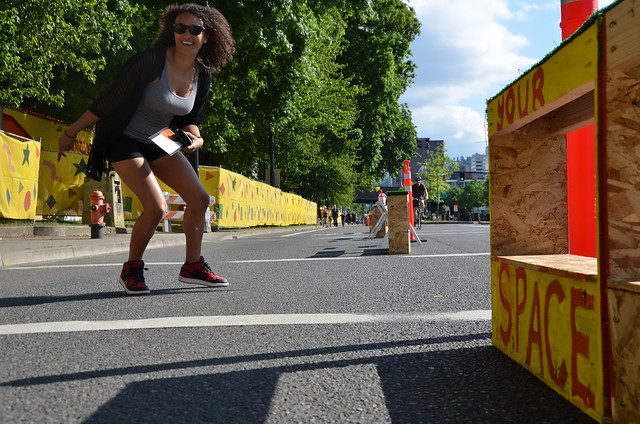
(Photo:M.Andersen/BikePortland)
Last month we learned that Better Block PDX, the group of dynamic street transformers whose work last year gave downtown Portland its first new bike lane in years, is scaling up and spreading out.
This news could hardly be better. Dozens of organizations around Portland would love to do for their area what Better Block volunteers have done for Waterfront Park, Old Town, SW Stark Street and SE Clinton Street: shown how much social and economic energy shows up when you weaken the automotive monopoly on most of our public space. If our local incarnation of Better Block can become a friendly partner with Portland’s diversity of neighborhood groups and with its city planners, it could change the way Portland thinks about change. If it can embed its ideas at Portland State University as its organizers hope, it could help change the way planners around the country do.
4) Our closest neighbor seems to be doing everything right
If Seattle were selling shares in its future, I’d be buying. In the last two years it’s notched success after success: a new bike plan, a bike-sharing system, an open-streets festival, a neighborhood greenway network, an internal goal to add seven miles of protected bike lanes in a year. In November, it approved a huge transportation levy that’ll add many miles of new protected or buffered bike lanes and neighborhood greenways, not to mention dedicated bus lanes and sidewalk fixes. This is the dream Portland has been chasing for years but has so far failed to find.
Seattle also elected a city council even more pro-bike and urbanist than the previous one, which seems likely to approve some sort of “grand bargain” to simultaneously allow more housing infill and more money for affordable housing. And it approved a new system designed to level the campaign-finance playing field by sending $100 in “democracy vouchers” to every Seattle voter, to be contributed to local campaigns.
Are we jealous? Obviously. But if we could wish those victories on any other city, it’d be the one that Portland most resembles and the one Portlanders are most likely to visit. These decisions are going to be great for Seattle over the year and decade to come. Portland will have a front-row seat, and that’ll be good for us.
5) The Portland Bureau of Transformation looks pretty interesting
First cones DEPLOYED! Find them; enjoy them. pic.twitter.com/4RgpXWm2Wa
— PDX Transformation (@PBOTrans) December 30, 2015
Last week’s traffic cone stunt might turn out to be a one-time gag, but it doesn’t look like it. Whoever the Portland Bureau of Transformation is or are, this New York-inspired group isn’t creating working infrastructure; obviously it’s a little more complicated than this. But in a city where conflict aversion sometimes becomes fear of one’s own tail, this does not really have to be that hard is exactly the argument more of Portland needs to be exposed to.
You might notice something about this list: Most of this good news is about good ideas that Portland is importing from other places. That’s a great sign. One of Portland’s challenges, especially in its political class, is the notion that Portland doesn’t need to look elsewhere for ideas. That’s never been true. Our most out-there ideas (surface rail built with freeway money, a riverside bike path beneath a freeway, a new streetcar line through a run-down warehouse district, a citywide network of bike-friendly side streets) were all inspired by successes elsewhere.
Portland has never had a history of actual invention. It’s had a history of well-executed theft. Let’s keep that up in 2016.
— Michael Andersen, (503) 333-7824 – michael@bikeportland.org


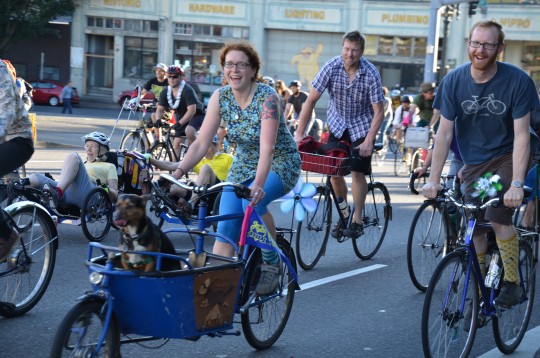
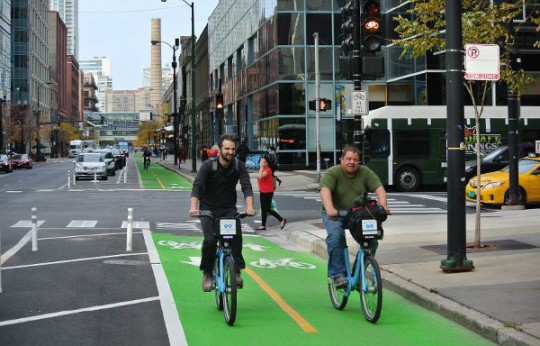
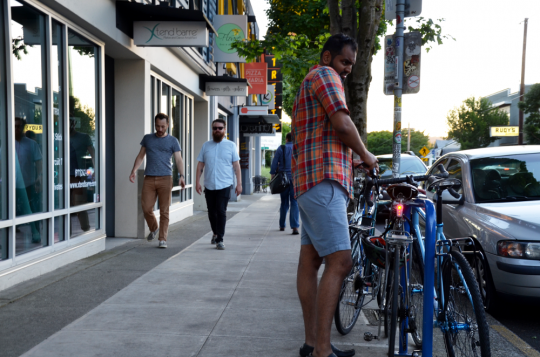
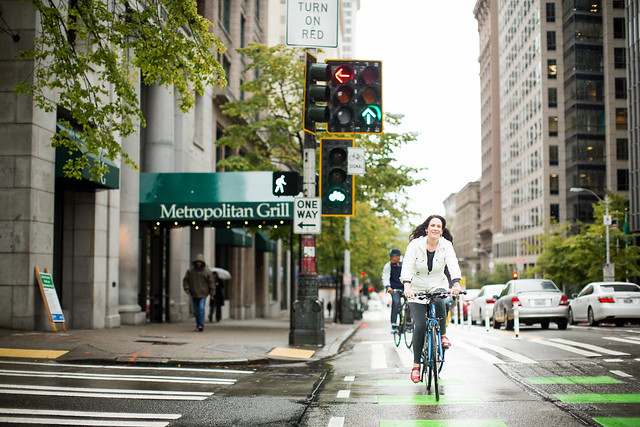

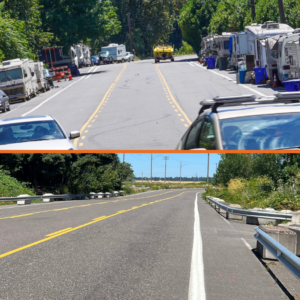
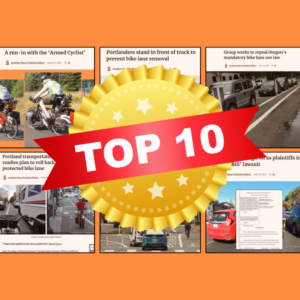

Thanks for reading.
BikePortland has served this community with independent community journalism since 2005. We rely on subscriptions from readers like you to survive. Your financial support is vital in keeping this valuable resource alive and well.
Please subscribe today to strengthen and expand our work.
great list…
“Portland has never had a history of actual invention. It’s had a history of well-executed theft. Let’s keep that up in 2016.”
except for bike theft, lets continue trying to keep that down…
I hate to be a downer, but pretty much all of the things listed for 2016 are things that were planned to occur much sooner.
Here’s to doing.
If pictures are worth a thousand words, actions are worth a million.
This list, and your perspective on it, Michael, gives me a burst of much needed optimism. Seems like 2015 kept getting more and more dire. I was as guilty as anyone of Portland Self-Congratulation Syndrome, and the last year or so certainly applied a much needed corrective. This new, humbler framing feels like a great way to start the new year.
I’m glad that bike share is finally happening but there is virtually no evidence that it has an impact on cycling mode share. I support bike share because I think it helps frame cycling in a positive way (and counters media-driven bikelash). Nevertheless, I’m more interested in doing the things that cities with 20-40% mode share are doing than in following the footsteps of cities with 1-3% mode share (e.g. NYC, Indianapolis, London, Barcelona, Paris).
Soren – I think Barcelona has made great strides. This “source” has them at 12%, and I recall seeing 7% elsewhere. https://en.wikipedia.org/wiki/Modal_share
Not saying that had much to do with bikeshare. I don’t know either way.
I stand corrected on Barcelona.
Except as non-Spanish citizens we couldn’t rent them (or European Union citizens, someone may have to clarify this).
Pretty moot though since we rented bikes fairly easily. Anyone else have the same experience in Barcelona?
My biggest hope for bike share is that it will push the City to finally (finally) build some high quality cycling infrastructure in downtown.
The city was awarded a $6 million dollar grant ~3 years ago and has yet to propose a single design.
It pains me too.
HIgh-quality cycling infrastructure downtown = close downtown to private motor vehicles.
🙂
I say you’re a dreamer, and you’re not the only one. Maybe we can start small and restrict noncommercial motor vehicles to one-quarter of downtown. That’s bike protection we can all get behind.
We should start with closing NW 13th in the Pearl to cars. It’s a no-brainer: there’s already no sidewalks, and plenty of foot traffic supporting the restaurants and shops. Plus, there’s already precedent from First Thursdays: if it works once a month, it can work the rest of the month.
And the park blocks.
The city has been too quiet on this project (now being referred to as the Downtown Multi-modal Project). As far as I know, it’s still alive. I spoke to Director Treat a few months ago and she mentioned the project as if it was still in progress. It’s disappointing that we still don’t have any new news on it, though.
I’m being optimistic that bike share will accelerate cycling road improvements in PDX. Why? Because the barrier of entry to cycle has been lowered to a mere few dollars which will hopefully mean more bikes on the road.
As for the item “Our closest neighbor seems to be doing everything right”,…I got all excited thinking it was about Vancouver (WAha). But noooo…If Seattle is your “closest neighbour”, then Vancouver WA must be a room mate or perhaps spouse. (As a married couple, Portland and Vancouver, would be in on-going off again marriage therapy…no restraining orders yet, just living in the same house and no longer dating or lovey.)
Vancouver is really more of a suburb of Portland. Seattle and Portland are the only two major cities in the American pacific northwest.
Ha! Exactly.
Perhaps saying our “largest neighbor” or “closest rival” would be clearer.
We would be wise to copy the other Vancouver.
Vancouver BC is the other major city in the American Northwest. (Canada is in North America, too!)
Well in Canada, Vancouver is considered to be in the Southwest.
But hey, it’s all relative and the world is a sphere and all that.
It’s good to see things getting better there and here.
Vancouver is the California of Canada!
Milwaukie is actually Portland’s closest neighbor. 🙂 Milwaukie City Hall is 5.9 miles from Portland City Hall. The next closest incorporated city to Portland is not Beaverton but little-know Maywood Park. Plus, Vancouver is absolutely, unquestionably, a suburb. Thus, it’s de facto included in the “our” of “our neighbor” considerations, because “Portland” generally means the entire Portland metro area. Otherwise, “our closest neighbor” would be Milwaukie.
Sorry, just having fun with this. 🙂 I totally concur that Seattle is the closest neighbor worth comparing ourselves with. Otherwise, our true closest non-metro neighbor of any decent size would be Salem, from which we can learn very, very little. 🙂
Anyway, regarding the main points:
1. Bike share is WAY more important and wonderful than most people realize. Even if you never use it, the benefits are incredibly deep and numerous. It MUST arrive in 2016.
2. Better Block PDX is *amazing*, and I’m going to help them out as much as possible. All great things start at the neighborhood and individual street level.
3. I should have mentioned this long ago: read Jane Jacobs’ entire unabridged “The Death and Life of Great American Cities.” Don’t just rely on people who’ve read it (and often misunderstand some of her most important points). It’s mind-blowingly transformational. She figured out EVERY single thing cities need to do to be successful. I’ve studied urban planning issues for many years, but her book (from 1961!!) destroys everything else combined. She has critically important lessons for EVERY people-friendly project initiative we’re trying to pursue in Portland. You’ll look at density, diversity, parks, border areas, “slums,” gentrification, politics, the economy, transportation and every single urban issue (including and especially walking and biking) totally differently and with FAR better insight.
4. It’s GREAT to look to Seattle (and New York, Montreal, Amsterdam, Copenhagen, Seville, etc) and get inspired to do great things in Portland. It’s a big part of why I travel all the time. Believe me, we have MUCH to learn from *every* major city on Earth these days. Like Anne Hawley said, “Portland Self-Congratulation Syndrome” is LONG in the rear-view mirror; it’s time to work harder than EVER in 2016 on behalf of creating a people-friendly city that functions well for ALL residents.
Lastly, the ONLY way to make ANY city work well transportation-wise is to prioritize in this exact order: 1. walking 2. cycling 3. public transit 4. delivery of freight/goods 5. private auto use. This works best for ALL people, including those who solely drive from A to B.
Great thoughts, Tim. (And yes, you’re right on Milwaukie.) I’m chiming in to say that at the recommendation of BikePortland Subversiveness Columnist Taz Loomans, I finally read a bunch of Death and Life in November. What a book. Totally agree that it’s worth it even for those of us who thought we’d picked it up by osmosis.